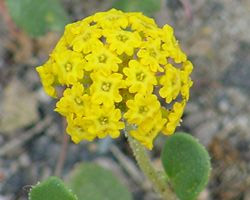Biology:Abronia (plant)
| Abronia | |
|---|---|

| |
| Yellow Sand Verbena (Abronia latifolia) | |
| Scientific classification | |
| Kingdom: | Plantae |
| Clade: | Tracheophytes |
| Clade: | Angiosperms |
| Clade: | Eudicots |
| Order: | Caryophyllales |
| Family: | Nyctaginaceae |
| Tribe: | Nyctagineae |
| Genus: | Abronia Juss.,[1] 1789 |
| Species | |
|
See text | |
Abronia, the sand-verbenas or wild lantanas, is a genus of about 20 species of annual or perennial herbaceous plants in the family Nyctaginaceae. Despite the common names, they are not related to Verbena (vervains) or lantanas in the family Verbenaceae. They are closely allied with Tripterocalyx.
They are native to western North America, from Alberta and Saskatchewan, Canada, south to west Texas , California , Baja California and central Mexico, growing on dry sandy soils. Abronia macrocarpa, a Texas endemic, is protected under the Endangered Species Act. Abronia ammophila, the Yellowstone sand verbena, is a plant unique to Yellowstone National Park's lakeshores and is endemic to the park. Only a few species are widespread, and many are quite rare. They make very attractive garden plants for hot, dry sandy sites.
Selected species
|
|
Formerly placed here
- Tripterocalyx carneus (Greene) L.A.Galloway (as A. carnea Greene)
- Tripterocalyx crux-maltae (Kellogg) Standl. (as A. crux-maltae Kellogg)
- Tripterocalyx micranthus (Torr.) Hook. (as A. micrantha Torr.)
- Tripterocalyx wootonii Standl. (as A. wootonii (Standl.) Tidestr.)[3]
Cultivation and uses
The stout, sweet root of Abronia fragrans and Abronia latifolia, sometimes over 60 cm long, can be eaten as a root vegetable.
References
- ↑ "Genus: Abronia Juss.". Germplasm Resources Information Network. United States Department of Agriculture. 2010-07-07. http://www.ars-grin.gov/cgi-bin/npgs/html/genus.pl?18. Retrieved 2010-10-24.
- ↑ "Abronia". Integrated Taxonomic Information System. https://www.itis.gov/servlet/SingleRpt/SingleRpt?search_topic=TSN&search_value=19550. Retrieved 2010-10-24.
- ↑ 3.0 3.1 "GRIN Species Records for Abronia". Germplasm Resources Information Network. United States Department of Agriculture. http://www.ars-grin.gov/cgi-bin/npgs/html/splist.pl?18. Retrieved 2010-10-24.
- Galloway, LA. 1976. Systematics of the North American desert species of Abronia and Tripterocalyx (Nyctaginaceae). Brittonia 27 (4): 328-347 (1975 publ. 1976)
- Flora of North America: Abronia
External links
Wikidata ☰ Q312349 entry
 |






